Marking Rehab – from appearance to impact
A few years ago I would have run around the classroom stamping student books with a “verbal feedback given” stamp, rather than ensuring the verbal feedback I gave was actionable and modelled what I wanted the student to do. I was preoccupied with getting my verbal feedback stamp out and stamping the students work to evidence that I had given feedback. Further to this I would spend my evenings meticulously going through students’ work writing extensive WWW and HTI comments, or whatever three letter initials we were using at that time. I would feel a warm glow of satisfaction when students responded in some way to this marking and I convinced myself that this time and effort I was putting in was having a significant impact on student learning.
However, marking very quickly got out of hand; it felt like an addiction. The more red pen I put in a student’s exercise book the better I felt. When I wasn’t marking, I felt a crushing guilt. I thought I was excellent at marking but was my marking making my students better geographers? SLT would look at my books and would praise me for the volume of red and green pen which positively reinforced the unhealthy relationship I had with marking.
Last year I led on the rewriting of the school’s marking policy. Initially, I thought the task would be straightforward but the deeper I delved into research and blogs, the more my eyes were opened to better ways, for both the teachers and the students. I would like to thank all of my fellow teachers who were kind enough to share their ideas through their blogs and help me shape a more effective feedback policy.
Below I will outline the steps I took to write and implement a new feedback policy and explain how I changed my mindset and tried to change that of the teachers.
1. Awaken to the problem
As I began to write the feedback policy, it became clear that I had many misconceptions about marking. I was convinced many of these misconceptions would have been shared among the staff body. When I ran an INSET on marking and feedback, I carried out a myth busting exercise, based on the advice given in the Marking Policy Review Group's report on "Eliminating unnecessary workload around marking." It was an extremely useful starting point to open teachers’ eyes to the many underlying myths around marking. For example, that Ofsted does not have a preferred style for written feedback, or that ineffective marking usually has a reliance on labour intensive techniques.
I felt this was an important first step in curing my addiction as well as the addiction of other teachers in the school.
2. Move to a Feedback Policy
The research from John Hattie and that provided by the Education Endowment Fund are clear: feedback can have a hugely positive impact on student learning. The EEF state that feedback, “is information given to the learner and/or the teacher about the learner’s performance relative to learning goals.” The EEF are also clear that “this feedback can be can be verbal, written, or can be given through tests or via digital technology. It can come from a teacher or someone taking a teaching role, or from peers.” The evidence suggests, therefore, that a policy should focus on all areas of feedback rather than focus exclusively on written marking and neglect other areas.
So firstly I changed the title; the marking policy was no more and the feedback policy was born. In the first page of the feedback policy I felt it was very important to clearly state that at Nova, feedback would be given through verbal feedback, peer and self-assessment, whole class feedback (as modelled so excellently by Michaela School) and finally through written marking by the teacher. For each type of feedback the policy states the form, frequency and response expected from the student.
3. Distinguish between Maintenance and Detailed Marking
Another problem I used to have in my days of marking addiction, was the meaningless tick. I would look at a page of student work, put a tick on it and maybe a throw away “good work” style comment. If I spent one minute per exercise book making these throw away comments, then that would be costing me hours and hours a year, for no impact on student learning. It sounds like madness as I type it out now, but I used to do it and I was truly convinced it was the right thing to do. I wanted no teachers to fall into this trap again.
Therefore, in the marking policy at Nova we have decided to distinguish between two types of feedback, detailed marking and maintenance marking (thank you to Alex Quigley of Huntington School for sharing this idea). Maintenance is used to inform whole class feedback, i.e. read the work of some students, look for common areas of strength and misconceptions and provide feedback to the class as a whole before the students carry out the necessary improvements. This method has been taken from the blogs of Jo Facer and has had a huge impact, both in terms of saving time for the teacher and impact on the learning of the students. Here is an example of how maintenance marking is presented to the whole class.

4. Get Faculties to decide the form, frequency and response for written marking
Finally, how could we shape a policy that enabled students to receive the most effective written feedback or detailed marking as it is described in the policy, whilst protecting teacher workload?
It had always seemed senseless to me that individual subjects are all constrained within a ‘one size fits all’ written marking policy. Again for compliance reasons it may be easiest to state that all departments mark in exactly the same way but surely this defeats the point of effective feedback? The way in which I would like to give written feedback in Geography would differ hugely compared to my colleagues in math, art or PE. Subject experts are in the best position to decide what to mark, how they should mark it and how often this should be done (form, frequency and response as it is called in the policy) .
All heads of department came up with individual written marking polices (see example below). Departments not only have ownership over their marking policy but also mark when it is appropriate for the learning of their students, not because a policy requires them to.

5. Move away from compliance to impact
Similarly to lesson observations, it is very easy to look for poor proxies when carrying out a work scrutiny (or marking scrutinies as they often are). As the government workload document states: “Deep marking often acts as a proxy for ‘good’ teaching as it is something concrete and tangible which lends itself as ‘evidence’. In some cases, the perception exists that the amount of marking a teacher does equals their level of professionalism and effectiveness. These are false assumptions.” I do feel that these attitudes to marking helped to feed my marking addiction earlier in my career, when I was desperate to please any observer who picked up my exercise book.
Again a culture change was required in those colleagues who were carrying out book scrutinies. We had to move away from looking at whether or not the feedback was done, to whether it was having an impact on student learning. To help facilitate this shift, I felt it was important in the feedback policy to include a guidance section for members of staff who were going to carry out work scrutinies. Thank you to Steve Adcock of United Learning for this guidance.
Some examples of questions we may want people to ask when carrying out a book scrutiny are outlined below. The list is by no means exhaustive but an example of the kind of questions we may wish to ask ourselves when carrying out book scrutinies:
- Is there a difference between a student’s ability to write coherent arguments since September?
- Does the student take more, less or the same amount of care in terms of presentation?
- Does the student complete tasks?
- Does the student spell words correctly that they used to spell incorrectly?
- Is the student using more complex language, whether in terms of terminology or syntax, than in September?
- Does the student refer to knowledge from previous topics in their current writing?
By using these stages at Nova, it has been refreshing to see that teachers are now referring to the impact of marking rather than whether or not it is completed. You can find our policy here.
Rhiannon Jones
9891